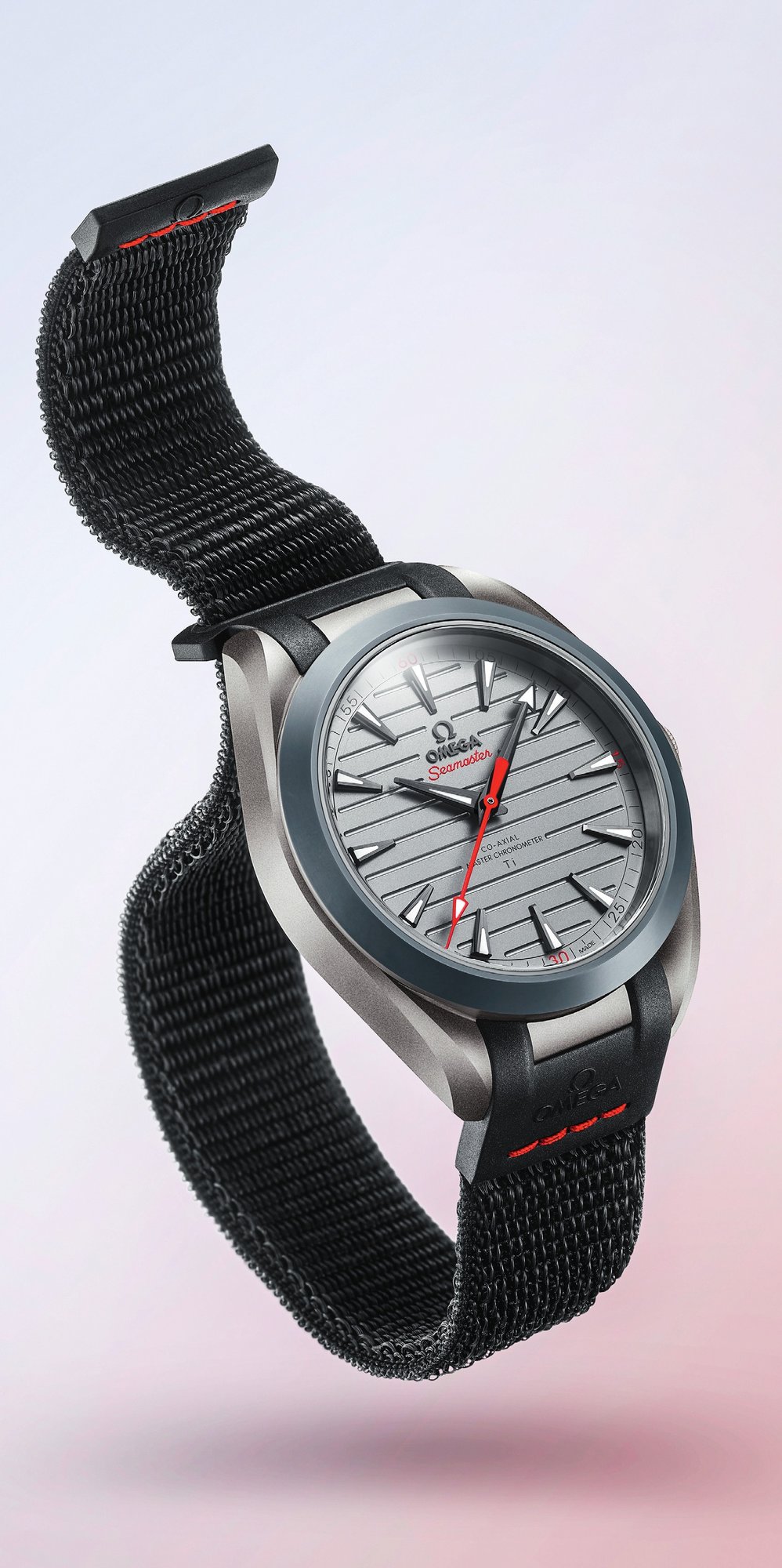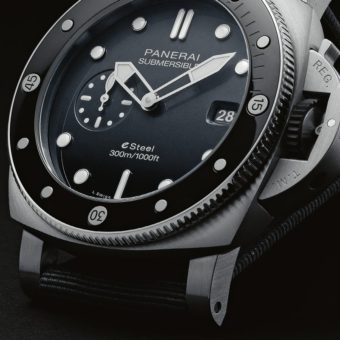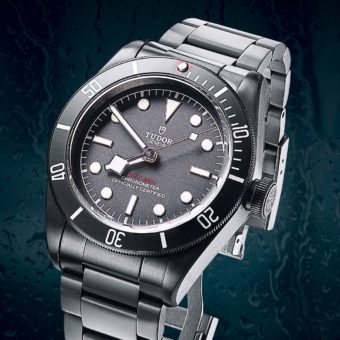This article was originally published in the May/June 2022 Issue of the WatchTime print magazine.
With the Seamaster Aqua Terra Ultra Light, Omega put its focus on a sporty look and innovative light weight. A fresh look at every detail resulted in a number of horological innovations. The hand-wound movement is Omega’s first titanium caliber — and implementation was no easy feat. After waiting over two years to get our hands on the watch, our editors had the opportunity to do a full hands-on test.
The “Ultra Light,” as we refer to this Omega watch, rather than by its full name, weighs only 55 grams on its black textile strap. According to our precision scale, the rubber strap with a titanium folding clasp bumps its weight up to 76 grams. For comparison, the Seamaster Planet Ocean with a titanium case, ceramic bezel and rubber strap weighs 104 grams, or about a third more. This is a valid comparison since the Ultra Light is made of exactly the same materials as the Planet Ocean while there are no comparable Aqua Terra models (apart from a couple of GoodPlanet versions). Titanium is the primary material used for the Ultra Light case. Not just any titanium — an alloy known as Gamma Titanium is used for the mid-section, the ring for the sapphire crystal threaded caseback and the crown. This is an absolute first for Omega.

This unusual material is an intermetallic compound of titanium and aluminum, also known by its scientific name: titanium aluminide (TiAl). Named after the third letter of the Greek alphabet, Gamma Titanium — or Γ-TiAl — consists of 50 to 55 percent aluminum, hence its light weight. TiAl-based alloys originated in 1970 but have only been used since the recent turn of the century.
Due to its robust properties and low density, titanium aluminide has found applications in aviation and aerospace as well as for sports equipment and in the automobile industry. Titanium aluminide is lighter and harder than conventional titanium. A discreetly engraved “Γ-TiAl” on the back of the upper left lug notes the use of this special material.
Titanium Grade 5, a much more common and the most widely used titanium alloy, is used for the sandblasted dial. This material is also light in weight, corrosion-resistant, biochemically neutral, and able to withstand extreme temperatures. Titanium Grade 5 is very similar in its light gray color to stainless steel and also goes well with the Ultra Light’s titanium aluminide case.

Omega conducted extensive research and testing with the goal of minimizing the amount of material needed for the dial. This, in turn, has reduced the overall weight of the watch without detracting from the recognizable look of the timepiece. The horizontal striping on the dial, which is typical for Seamaster models, makes its mark here in negative relief. Also recognizable without a doubt, are the triangular applied hour markers, which taper toward the center of the dial, and the striking hands with arrowhead tips on the minute and second hands. The second hand is made of aluminum — red aluminum for our test watch, which matches the Seamaster name below the raised Omega logo at 12 o’clock, the quarter-hour numerals on the minute or seconds track on the edge of the dial, and the contrasting stitching on the rubber or textile strap (also available in a choice of blue or green).
A ceramic bezel frames the titanium dial. This is a preferred material at Omega because it is especially scratch-resistant. It was developed in a unique color for the Ultra Light so that the bezel coordinates with the titanium case and titanium dial. Depending on the viewing angle and the angle of light, the fixed ring sometimes appears to be the same color, even though it is slightly darker than the case mid-section and dial.

When viewed from above, the case appears streamlined and symmetrical. The right flank, which is virtually invisible from this perspective, increases the size of the case by 2.5 mm, to a generous 43.5 mm across when measured from 9 to 3 o’clock, but only 41 mm from 12 to 6 o’clock. When viewed from the side, however, the diamond-shaped flank is a feature that stands out and accommodates the attractive crown.
Because this operating element is deeply seated in the flank, one wonders how to access it. This technology is unique: you press the crown like a push button to release it and allow it to glide out from its recess. This makes interacting with the manual-winding feature an exceptional experience in itself, and because the Ultra Light is a hand-wound watch, it can be enjoyed every day. With its three-day power reserve, it’s not necessary to wind the Ultra Light every day — but it’s tempting to use the telescopic crown once a day, or more.

Other operating elements are more conventional, and also slightly more difficult to use. The Gamma Titanium crown has to be pulled into the middle and outer position in the conventional way, with considerable effort and using your fingernails. The Ultra Light has no date display, so there is no quick-date adjustment in the middle position. Instead, there is the practical time-zone function that Omega adds to almost all of its newer movements. The hour hand can be moved forward or back as needed without affecting the precise setting of the time.
When traveling to a different time zone, this extremely practical and modern feature allows you to set the current local time very easily. And after winding the watch to the point of mild resistance, the crown turns back just a bit — and then a light push will return it to its secure position within the case.
If the crown was previously pulled to the middle or hand-setting position, you will hear an audible click and know that the crown is back in its original position. From the winding position, the telescopic crown glides just as smoothly back into the case as it exited. This also reveals another nice detail: the red Omega logo can be situated in any direction, exactly as you would like it to be. In contrast to a screw-down crown, the telescopic crown remains movable within the flank.

This unique crown is used to operate a unique movement — the Omega hand-wound Caliber 8928 Ti. As one has come to expect from Omega, this is a METAS-approved Master Chronometer. This means that the hand-wound movement and the watch have passed a series of tests that show that they are resistant to magnetic fields of at least 15,000 gauss. But because the Ultra Light was designed to be especially lightweight, a number of measures had to be taken with regard to the movement as well. Caliber 8928 Ti is Omega’s first titanium movement. It goes back to Caliber 8900, the first movement certified by METAS as a Master Chronometer, but it is even traceable back to the first chronometer movement with a Co-Axial escapement, Caliber 8500.
With Caliber 8928, not only is the balance wheel made of titanium, but the mainplate and bridges are made of ceramic titanium. This gives the hand-wound movement its coordinating dark-gray color, which is clearly visible through the sapphire crystal caseback. Its light weight also means there is less friction between the various components.

The free-sprung silicon hairspring vibrates at a rate of 25,200 vph and is powered by two serially arranged barrels for a power reserve of three days. According to Omega, the low weight does not reduce accuracy or performance of the movement, so Omega confidently offers a five year warranty for the Ultra Light. In our extensive testing process, we identified some rate variation, but the values remained within the chronometer range. When fully wound, the watch gained an average of only 1.4 seconds per day on the timing machine, but 2.3 seconds on the wrist with daily winding. The Ultra Light showed greater deviation after 24 hours or longer without winding but never exceeded 4 seconds per day.
A long, narrow needle, with a fine tip worthy of a precision timekeeping unit, points to the small time-unit scale on the dial side. Sometimes you need to turn the Ultra Light just the right way to see the seconds/minutes track around the edge of the dial or move it away from the light to avoid an occasional reflective flash from the polished and brushed finishes on the markers and hands. At night, all these elements glow a bright blue that lasts to a greater or lesser extent, depending on the charge of the Super-LumiNova.
Looking at this watch is always a pleasure and never overwhelming. Quite the opposite: both its size and its subdued color scheme give the Ultra Light a look of gray eminence. It comes on a distinctively patterned black rubber strap with contrasting red, blue or green stitching that matches the second hand and other details on the dial. A few waves on the back of the strap provide ventilation and ensure the best wearing comfort in addition to its lightness.

There will be times you forget you’ve got the Ultra Light on your wrist. The perforated end of the rubber strap is threaded through a titanium folding clasp and held securely in place with a pin. Switch to the additional textile strap if you want it to be even lighter.
The price also raises the Seamaster Aqua Terra Ultra Light above the rest of the pack. Even though there is no other directly comparable model, the Seamaster Aqua Terra collection itself offers an entry model in stainless steel (Ref. 220.13.41.21.01.001) priced at $5,400. With its list price of $48,600, a decision for this ultra-lightweight watch is certainly not to be taken lightly.
Omega Seamaster Aqua Terra 150 M Co-Axial Master Chronometer 41 MM Ultra Light Specs:
Manufacturer: Omega S.A., Stämpflistrasse 96, 2504 Biel/Bienne, Switzerland
Reference number: 220.92.41.21.06.001
Functions: Hours, minutes, central sweep seconds, time-zone function
Movement: In-house movement 8928 Ti based on Omega 8900 automatic, manual winding, chronometer, 25,200 vph (3.5 Hz), 29 jewels, silicon Si 14 hairspring, titanium balance wheel, fine adjustment with regulating weights on balance wheel, Nivachoc shock absorber, 72-hour (3 days) power reserve, diameter = 29 mm, height = 4.2 mm
Case: Titanium aluminide (Γ-TiAl), domed sapphire crystal with anti-glare coating on both sides (top), sapphire crystal caseback, water resistant to 150 m
Strap and clasp: Rubber strap with one-sided titanium folding clasp, additional textile strap
Rate results: Deviation in seconds per 24 hours (Fully wound / after 24 hours)
Dimensions: Diameter = 41.01 mm (from 12 to 6 o’clock), 43.52 mm (from 9 to 3), height = 13.74 mm, lug width = 19.5 (Omega-specific), weight = 76.0 g
Variations: With dial details and strap stitching in blue (Ref. 220.92.41.21.06.002, $48,600) or in green (Ref. 220.92.41.21.06.003, $48,600)
Price: $48,600
Scores:
Strap and clasp (max. 10 points): Lightweight ergonomic straps, high quality non-allergenic titanium clasp. 9
Case (10): Innovative material: Γ-TiAl, ceramic, two sapphire crystals, excellent workmanship, unique telescopic crown. 9
Dial and hands (10): Light-colored titanium dial, following the conceptual design of the watch; recognizable thanks to the horizontal striping, the hands and the markers. 9
Design (15): Designed with light weight as its ultimate goal with no negative impact to its look; clearly recognizable as a Seamaster Aqua Terra. 14
Legibility (5): Occasional reflections on the markers and hands, Super-LumiNova strength is limited. 4
Operation (5):
Innovative telescopic crown, the hand winding position works very well but it is more difficult to access the other crown positions, excellent clasp. 4
Wearing comfort (5): Very good wearing comfort thanks to the low weight and excellent ergonomic design. 5
Movement (20): Master Chronometer is one of today’s highest quality movements, the titanium movement matches the overall concept of this watch. 19
Rate results (10): The hand-wound watch runs with minor variations depending on the winding state, but always remains within chronometer specs and always in the plus range. 9
Overall value (10): Omega has created a “talking piece” with a very high innovation level, but at a perplexingly high price. 7
TOTAL: 89 points
To learn more about Omega, click here, and to subscribe to the WatchTime print magazine, click here.







Fantastic to see the AT without a date function. I wish the rest of the AT’ had that option. This is a great variation!